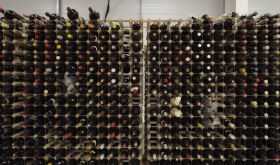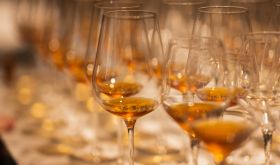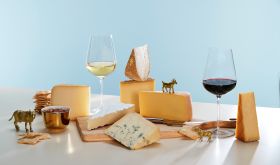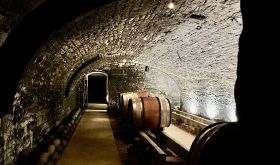10 March 2015 On 22 February 2015 the Lett family celebrated the precise 50th anniversary of the day on which the late David Lett planted the first Pinot Noir vine in Oregon’s Willamette Valley. This region was the first outside Burgundy to have devoted itself to the Pinot Noir grape (although Michael Schmidt has leaped to the defence of the Ahr Valley in Germany) and has now established itself as a nucleus of fine Pinot production peopled by like-minded, generally co-operative, underdog non-conformists. (See here for Oregon’s wine history in full in your online Oxford Companion to Wine.)
The Oregon wine industry evolved as a sort of counterculture, a Not California, although of course Pinot Noir had been grown in California, and pioneered by the likes of Paul Masson and Hanzell before anyone thought of planting it in the much cooler state to the immediate north. Although Switzerland has a much longer history of growing Pinot Noir, I find it difficult to think of anywhere else outside France that was taking the variety seriously in the mid 1960s, but perhaps someone can correct me via a post on our Members’ forum? Chacra in Argentine Patagonia has some Pinot Noir vines planted in 1932 but they were abandoned for many years. John Middleton of Mount Mary planted Pinot Noir in the Yarra Valley but not before 1972. I’m sure someone will correct me with some other suggestions, but when I began writing about wine in the mid 1970s it was accepted wisdom that Pinot Noir would never be produced successfully outside Burgundy.
So it was a special pleasure to be able to attend a commemorative tasting for several hundred friends of Eyrie Vineyards in the Portland Art Museum. They had all bought tickets, but I cannot understate the human warmth apparent in the Fields Ballroom that Sunday afternoon.
![]()
David’s widow Diana Lett, who told the room ‘we’ve known each other since before winemaking or Oregon were hip’, explained how, after David’s death at the age of 69 in 2008, they discovered a cache of his notebooks, cuttings and photographs such as the one here of him planting the early vines at the Corvallis nursery.
His son Jason, who now runs Eyrie, gave us an illustrated presentation of his father’s intentions and achievements, not least in the form of wines going back to a rare 1972 Pinot Noir and 1977 Pinot Gris in the most superb shape. Truly, it was the vivacity of the older white wines, both Chardonnay and Pinot Gris, that were the real revelation for me, as you can see from my tasting notes below. But it was heartening that he began his talk with a vote of thanks to the vineyard manager Javier Garcia, ‘who has been intimately involved, with his relatives, in making all our wines from 1985'. At Eyrie there has never been a separation between vineyard and cellar work.
The run of four flights, one for each decade, was followed by a showing of five current single-vineyard bottlings that were most convincing, and whose labels are decorated with Jason’s impressively accomplished watercolours of each vineyard site.
![]()
David Lett loved making wine but hated selling it, and was a great hoarder of bottles. The family have accordingly been left with a 6,000-case legacy of mature wine. Jason’s researches suggested that by no means all of them were in pristine condition, largely thanks to TCA, so has developed a 21–step system of checking and recorking every single one. These wines are now available commercially and profits from those sold on the day of the tasting went towards the Cascades Raptor Center. A peregrine was brought along for the ride. The red tail hawk has always been on the Eyrie label since they circle over the vineyards, the name Eyrie having been chosen by David even though ‘no one could spell, pronounce or understand it’.
Here’s to the next half-century, and to the future of Oregon wine.
The wines are presented in the flights and order tasted.
SEVENTIES
White
Picked 17 October, Brix 23.2, pH 3.26. Only one day in May made it past 21 ºC, and rain was twice normal... not great for flowering! June was very nice, and the vines managed to complete set by early July. September gave us twice the normal amount of precipitation, with gradually cooling temperatures which extended into October. A miraculous rarity made from the first Pinot Gris planting outside Europe, which quickly caught on. Now it’s second only to Chardonnay in Oregon for white wines. From just four rows – original vines.
Pale honeyed gold. Very mature nose with some marzipan but great acidity and precision. Scented. Mid to heavy. Very long. (JR)
White
Picked 12 October, Brix 21.8, pH 3.43. Dry and relatively cool April-June. Good bloom. Very warm July. Moderating temperatures through August. September just slightly warmer than 1972, and like '72 a scary three-inch accumulation of rain in the third week. Temperatures gradually cooled during the last part of September and through harvest in early October. All cuttings came from their friend Jerry Draper on Spring Mountain. He pointed out individual vines he thought would do well in Oregon. Called the Draper Selection. But the Draper ranch no longer has any Chardonnay. The Eyrie clone Chardonnay will be released from Davis in the next few years – ‘really fun to be able to give something back to California’, comments Jason Lett.
Very fine and delicate – awfully like a fine white burgundy! Really long and complete. (JR)
Red
Picked 29 October, Brix 23.5, pH 3.6. March and April were cool, but temperatures rose in May up to high 70s and low 80s. June gave good (albeit late) set conditions. The last two weeks of July were warm and dry. August temperatures provided perfect maturation conditions for the grapes, slow and cool. Rain came in small doses. The protracted coolness of September and October captured all the flavour possible for this vintage. In David’s opinion 1976 and 1975 were the best of the decade. Aged for three years in barrel. David Lett would sometimes age special barrels for three rather than one and a half years. 22 cases came from one barrel, so it was almost certainly never released: ‘Dad liked it too much’.
Pale brownish ruby. Very pale rim. Light nose and showing some marginal decay but great palate with firm structure. Spicy and with a little bit of tannin still. Pale finish. But actually it’s quite amazingly persistent and reminds me of a herbal red vermouth. Grew in the glass. (JR)
Red
Picked 4 October, Brix 22.5, pH 3.53. Good bloom conditions in June. July and August were much hotter and drier than normal. September cooled into beautiful slow ripening conditions albeit with a rather scary three inches of rain in the third week of the month. Skies cleared and stayed that way with gradual cooling through the end of October giving us ideal ripening and harvest conditions.
Earthy nose and a bit of dried earth on the finish. Definitely losing fruit. (JR)
EIGHTIES
White
Picked 4 October, Brix 20.8, pH 3.37. A perfect year! April temperatures were in the high 60s. May was mixed but June had perfect bloom. Temperatures cooled in July and then warmed up again in August, which was dry except for the last four days with 1.6 inches of rainfall. September displayed ideal maturation temperatures and well below average in precipitation. Our harvest was completed by October 13th. 81% Estate, 19% Fuqua, Adelsheim, and Elstrom vineyards.
Off dry and really quite Alsacien. Amazing depth and structure. (JR)
White
Picked 5 November, Brix 18.4, pH 3.5. April and May were very cool and wet. June showed only average flowering conditions. Set was not complete until July, which was warm and dry. August had cooler than usual temperatures. September was also cool. October was a damp month, cool and overcast. We kept waiting for the weather to clear and warm, and didn’t pick until November! The grapes had no rot, and due to heroic measures by our vineyard manager, came into the winery warm and dry. Very hard vintage with horribly wet autumn. Very late vintage but hardly any ripeness. Chaptalised to add three more per cent alcohol.
Lots of chew and not much flesh. Menthol. A bit coarse in texture. (JR)
Red
Picked 22 September, Brix 19.0, pH 3.84. April was a beautiful mix of showers and sun. Warm, dry weather began in May and continued into June creating perfect bloom conditions. July was cooler, but August was hot with no rainfall. September temperatures were lower than normal with the entire month’s rainfall coming in the last two weeks and causing some picking panic. We picked before and after the rains. Low Brix prompted chaptalisation in the winery to get sugars up to 22˚. Aged three years in barrel.
Lively and fresh on the nose. Spicy again and a little hard and slightly tough on the end. Very definitely needs food. Dry finish. Perhaps David Lett kept it because he was worried about the tannins. Falls away fast. (JR)
Red
Picked 17 October, Brix 23.4, pH 3.62. April was generally cool and rainy. May was about average for rainfall, but very much above average for volcanic ash from the Mount St Helen’s eruption on 25 May. June wasn’t terrific for bloom with twice the usual rainfall and lower than normal temperatures. Bloom was not completed until early July. July and August were quite warm with no rain. September was average, but October’s first ten days were warmer than usual. Yields came in at only 0.8 tons per acre.
Violets on the nose – very pretty, masses of fruit, sweetness, structure and density. Marvellous relic really and with such vigour. (JR)
NINETIES
White
Picked 10 October, Brix 22.6, pH 3.31. A long, cool spring pushed into late June and early July (much like 2008). The rest of the season was ideal, however, with a long warm fall. As is typical of years with a more extended ripening season, quality was excellent but showed itself best after a few years in bottle. 87% Estate, 13% Croft and Elstrom.
Honey colour. Marzipan and fragrant. Then youthful grip and acidity. Miraculous for the age. Lovely rich finish and undertow but much livelier than most Alsace examples. Miracle of longevity. (JR)
White
Picked 9 October, Brix 21.0, pH 3.44. A good growing season with rain at harvest. With their unshakeable belief that rain is somehow bad for plants, many writers rated the vintage poorly at first. However, like other cooler vintages, the ultimate outcome has been wines of elegance and age-worthiness. Pinots and Chardonnay are both showing beautifully from 1995.
Sweet and rich but with lots of acidity too. Racy and nervy with some herbal quality. Lots of substance. Substantial. Improved in the glass. Lots of polish. (JR)
Red
Picked 30 September, Brix 23.8, pH 3.5. In 1998, warm winter temperatures started the vines into action earlier than usual. Unfortunately, late spring rains fell during flowering reducing most wine grape crops in Oregon by half. Bloom occurred more slowly also. The clusters were filled with ‘shot berries’ (very tiny berries that are mostly skin). This is great for wine quality, but not so great for winery economics. At harvest the quality was outstanding. The accountant’s loss was the collector’s gain.
Autumn mulch on the nose. Dry finish. Herbal thread. Very pure and correct mature Pinot and only medium body. Really quite remarkable poise. Youthful! Very clean. (JR)
Red
Picked 5 September, Brix 23.0, pH 3.6. Even including 2014, 1992 was still the hottest year in Oregon’s brief viticultural history, with harvest commencing early September. Fortunately, the heat relented somewhat at the end of picking, allowing many producers to make wines of outstanding quality. However, it was our earliest harvest ever and, as with many hot vintages, the challenge was to preserve the elegance of the fruit in a year with a shorter ripening span.
Mid ruby. Violets on the nose and extreme sweetness on the palate. A little jagged but so full of oomph. Kerpow! Côte de Nuits – definitely! Still some fine tannins here. (JR)
TWENTY-FIRST CENTURY
White
Picked 9/24, Brix 23.2, pH 3.44. The 2004 vintage in Oregon was a veritable roller coaster ride! Unusually cool weather early in the season kept the crop relatively low, while a dry and hot summer put sugar levels higher than expected. Luckily, the weather calmed a bit right before harvest, with cooler temperatures and a small amount of rain helping to tame the sugars and promote flavour ripeness, as well as delay what was going to be an early and overripe vintage.
Pale orange gold. Very scented and off dry but with good precision. Quinine and fun. Medium to full bodied. Neat and concentrated. (JR)
White
Picked 22 October, Brix 22.6, pH 3.29. In 2002 a cool early spring with normal precipitation was followed by warm, dry conditions in late spring at fruit set, giving us perfect crop levels. The warm, dry weather continued through summer and fall with few extremes of heat, leaving us with perfectly balanced and ripe fruit. The 2002 vintage is considered one of the Willamette Valley’s finest vintages.
Clean, fresh and quite skinny and vegy. Racy and medium bodied. Savoury and correct. (JR)
Red
Picked 14 September, Brix 20.1, pH 3.5. After four years of unusually warm growing seasons, Oregon experienced a classically styled vintage for the state, with wines that are balanced and elegantly fruit-forward. The 2005 season began with one of the driest winters and wettest springs on record. While the cool, rainy spring was a relief for drought-stricken parts of the state, the grape set was uneven and we experienced modest yields of about 1.5 tons per acre. The summer was very mild. Jason Lett assured us we should discern ‘the taste of terror’ in this vintage, his first, his father having recently been diagnosed. Jason was, he admits now, too fussy about winery hygiene, keeping the crew up until two in the morning while the press was scrubbed as never before.
Light and a little tart but very much in the modern idiom. Just the sort of Pinot Noir everyone wants to make now! Very sleek and lovely and refined. (JR)
Red
Picked 5 October, Brix 23.1, pH 3.44. The 2007 growing season began with slightly warmer temperatures, providing ideal conditions for fruit set. Weather was moderate throughout the summer and fall. In 2007 patience was key, as we waited for sugars to complement physiological ripeness. This was David Lett’s final cuvée. Shortly before he passed away in October of 2008 he blended the South Block, and it was re-barreled for a further 16 months before bottling in 2010. Jason was keen at the time that he and he alone should direct the winemaking. He says he saw David throw a bunch of stems in from the destemmer but his father denies this.
Whatever the recipe, this is a stunning wine (that does taste as though there were some stems in there). Racy and transparent and lots of fruit and racy. So fresh! (JR)
SINGLE-VINEYARD BOTTLINGS
All five produced in 2012 for the first time, with watercolours of each vineyard by Jason Lett on the labels.
Red
25-year-old vines at 60-110 m elevation from a terroir that abuts granite. 4-acre vineyard.
Very pale crimson. Light and fresh with delicacy and lots of acidity. Cool. (JR)
Red
Vines, in a 5-acre vineyard on volcanic soils that used to be known as Eason, are 15-31 years old.
This is quite rich and round with the most beguiling top note of violets and beautiful precision on the palate. Seriously scrummy. (JR)
Red
26-year-old, 5.1-acre vineyard cooled by incoming breezes and named, sort of, after a relative called Roland Green.
Lightly vegetal nose and chunky palate on this youthful wine. Very solid, lightly medicinal and bumptious. (JR)
Red
The highest and smallest of these vineyards at 275 m and 1.5 acres. Indeed it is one of the highest vineyards in the Dundee Hills. Vines are 41 years old.
Deep crimson. Solid, dense, sinewy wine that seems drier than the rest. In fact it is still pretty austere and chewy. A real long-distance runner. (JR)
Red
These vines, at 70-120 m, are between 30 and 50 years old, so include some of those planted on 22 February 1965, the event celebrated at this tasting in Portland, Oregon. 7-acre vineyard.
Great juice, fruit and depth. Yet there is sufficient zip and raciness to keep the wine refreshing – with good structure underneath. (JR)
















